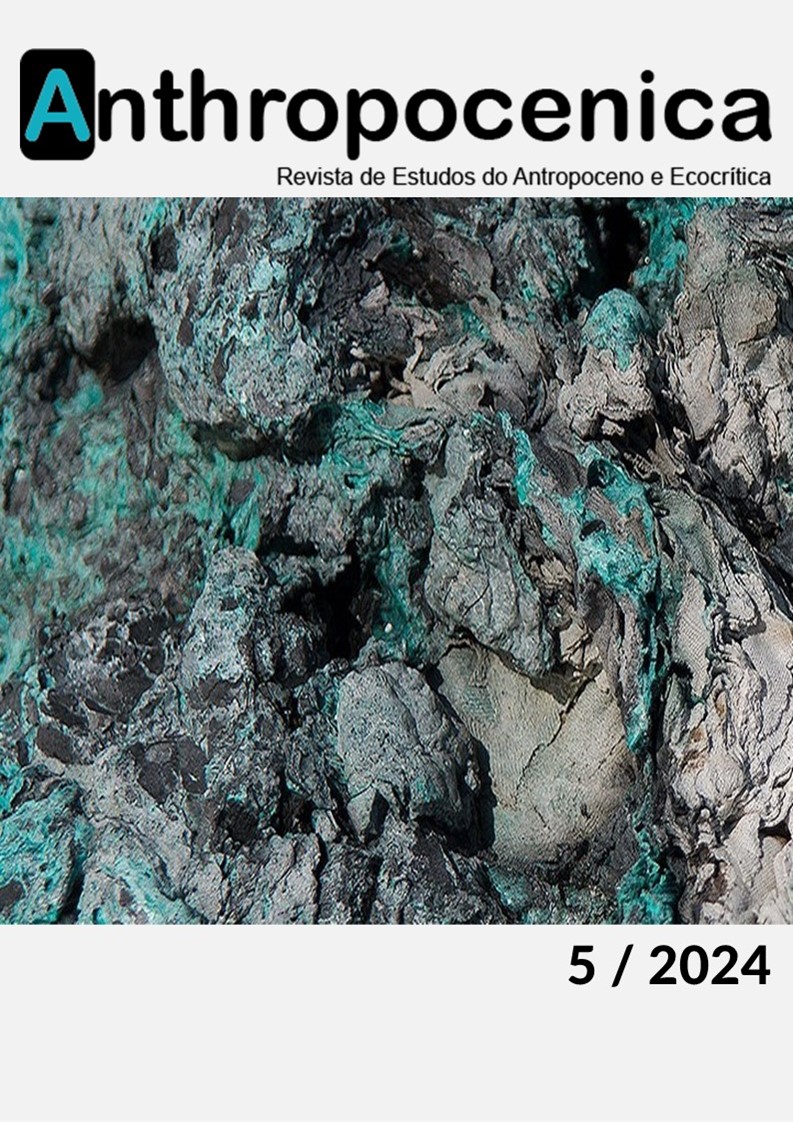The human condition in the Anthropocene-four chakrabartian parallaxes
DOI:
https://doi.org/10.21814/anthropocenica.6024Palavras-chave:
Condição humana, Antropoceno, Dipesh Chakrabarty, ParalaxeResumo
O Antropoceno marca uma era crucial em que a atividade humana se tornou a força predominante que molda a geologia e os ecossistemas da Terra. Essa mudança exige uma reavaliação profunda do que significa ser humano. Este trabalho investiga o conceito de “condição humana” no contexto do Antropoceno, recorrendo às reflexões filosóficas de Dipesh Chakrabarty. O artigo está organizado em duas partes principais. A primeira parte delineia o significado de “condição humana”, situando-o num contexto filosófico e histórico mais amplo. A segunda parte analisa como o Antropoceno transformou a nossa compreensão da condição humana, alterando as perspetivas tradicionais sobre a agência humana, a temporalidade e o impacto planetário. Através desta análise, são apresentadas novas perspetivas sobre as dimensões existenciais e éticas de ser humano numa era marcada por uma profunda transformação ecológica.
Downloads
Referências
Baudrillard, J. (1983). Les strategies fatales. Bernard Grasset.
Bonneuil, C. (2023, March 30). Le global et le planétaire: À propos de Dipesh Chakrabarty, Après le changement climatique, penser l’histoire. Gallimard. https://laviedesidees.fr/IMG/pdf/20230310_chakra.pdf
Chakrabarty, D. (2016 [2015]). The human condition in the Anthropocene (Yale University, 18-19 February 2015). In M. Matheson (Ed.), The Tanner Lectures on Human Values (Vol. 35, pp. 137-188). University of Utah Press.
Chakrabarty, D. (2021). The climate of history in a planetary age. University of Chicago Press.
Chakrabarty, D. (2021a). Introduction. In D. Chakrabarty, The climate of history in a planetary age (pp. 1-20). University of Chicago Press.
Chakrabarty, D. (2021b). Toward an Anthropological Clearing. In D. Chakrabarty, The climate of history in a planetary age (pp. 182-204). University of Chicago Press.
Chakrabarty, D. (2021c). Postscript: The Global Reveals the Planetary. A Conversation with Bruno Latour. In D. Chakrabarty, The climate of history in a planetary age (pp. 205-217). University of Chicago Press.
Chakrabarty, D. (2021 [2009]). Four Theses. In D. Chakrabarty, The climate of history in a planetary age (pp. 13-48). University of Chicago Press.
Chakrabarty, D. (2021 [2018]). Anthropocene Time. In D. Chakrabarty, The climate of history in a planetary age (pp. 155-181). University of Chicago Press.
Chakrabarty, D. (2021 [2019]). The Planet: An Emergent Humanist Category. In D. Chakrabarty, The climate of history in a planetary age (pp. 68-92). University of Chicago Press.
Chakrabarty, D. (2023). One Planet, Many Worlds: The Climate Parallax. Brandeis University Press.
Clark, N. & Szerszynski, B. (2021). Planetary Social Thought. The Anthropocene Challenge to the social sciences. Polity Press.
Crutzen, P. J., & Stoermer, E. F. (2000). The “Anthropocene.” Global Change Newsletter, 41, 17-18.
Daintith, J. & Gould, W. (Eds.). (2005). The Facts on File Dictionary of Astronomy (5th ed.). Facts on File.
Descartes, R. (1966 [2019]). Discours de la méthode. Garnier-Flammarion.
Ebbesen, D. K., & Olsen, J. (2023). Exploring the Preconditions for a Developmental Science: Hegelian Metaphysics and Dialectics. Human Arenas, 6(2): 328-342. https://doi.org/10.1007/s42087-021-00210-5
Haraway, D. (2015). Anthropocene, Capitalocene, Plantationocene, Chthulucene: Making kin. Environmental Humanities, 6(1), 159-165.
Kagan, J. (2009). The three cultures: Natural sciences, social sciences, and the humanities in the 21st century. Cambridge University Press.
Lewis, S. L., & Maslin, M. A. (2015). Defining the Anthropocene. Nature, 519(7542), 171-180.
Mendes, J. (2023). Thinking Planetary Thinking. Filozofia, 78, Supplement “Philosophical Examinations of the Anthropocene”, 24-37.
Montaigne, M. E. de. (1993 [1580]). Essays (J. M. Cohen, Trans.). Penguin Books.
Montaigne, M. E. de. (1595). Essais, éd. Posthume (établi par Pierre de Brach et Marie de Gournay). Abel L'Angelier.
Moore, J. W. (2017). The Capitalocene, Part I: On the nature and origins of our ecological crisis. The Journal of Peasant Studies, 44(3), 594-630.
Ortega y Gasset, J. (1964 [1939]). Meditación de la técnica. In J. Ortega y Gasset, Obras completas, Tomo V (1933-1941) (6th ed., pp. 317-375). Revista de Occidente.
Präkel D. (2009). The Visual Dictionary of Photography. AVA Publishing
Sartre, J.-P. (1946). L'existentialisme est un humanisme. Les Editions Nagel.
Sartre, J.-P. (2007 [1946]). Existentialism is a humanism (C. Macomber, Trans.; A. Cohen-Solal, Intro.; S. Elkind-Sartre, Notes & Preface; J. Kulw, Ed.). Yale University Press.
Snow, C. P. (1959). The two cultures. Cambridge University Press.
Steffen, W., Broadgate, W., Deutsch, L., Gaffney, O., & Ludwig, C. (2015). The trajectory of the Anthropocene: The Great Acceleration. The Anthropocene Review, 2(1), 81-98.
Stoppani, A. (1873). Corso di geologia (vol. 2: Geologia stratigrafica). Bernardoni e Brigola.
Wenders, W. (Director). (1987). Der Himmel über Berlin [Film]. Road Movies.
Weisman, A. (2007). The world without us. Thomas Dunne Books/St. Martin's Press.
Wilson, E. O. (1998). Consilience: The unity of knowledge. Knopf.
Žižek, S. (2006). The parallax view. The MIT Press.
Žižek, S. (2023, January 23). A cancel culture parallax. Compact. https://www.compactmag.com/article/a-cancel-culture-parallax




